What do washing symbols mean?
At first glance, the little cleaning symbols on your clothes and textiles don't make any sense.
What's more, there seem to be so many different ones.
How are you supposed to know exactly what the washing symbols mean and how you should really wash your bed linen and other items? 🤷♀️

The system for laundry symbols is actually relatively simple and once you have understood the basics, the problem of correct washing is solved.
In general, there are 5 different laundry symbols, as you can see in the following table:
| Washing list symbols | Meaning |
| Bucket/tub | washing |
| Triangle | Bleach |
| Square | Drying |
| Iron | Ironing |
| Circle | Dry Cleaning |
So you can already recognise what a symbol is about from its geometric shape.
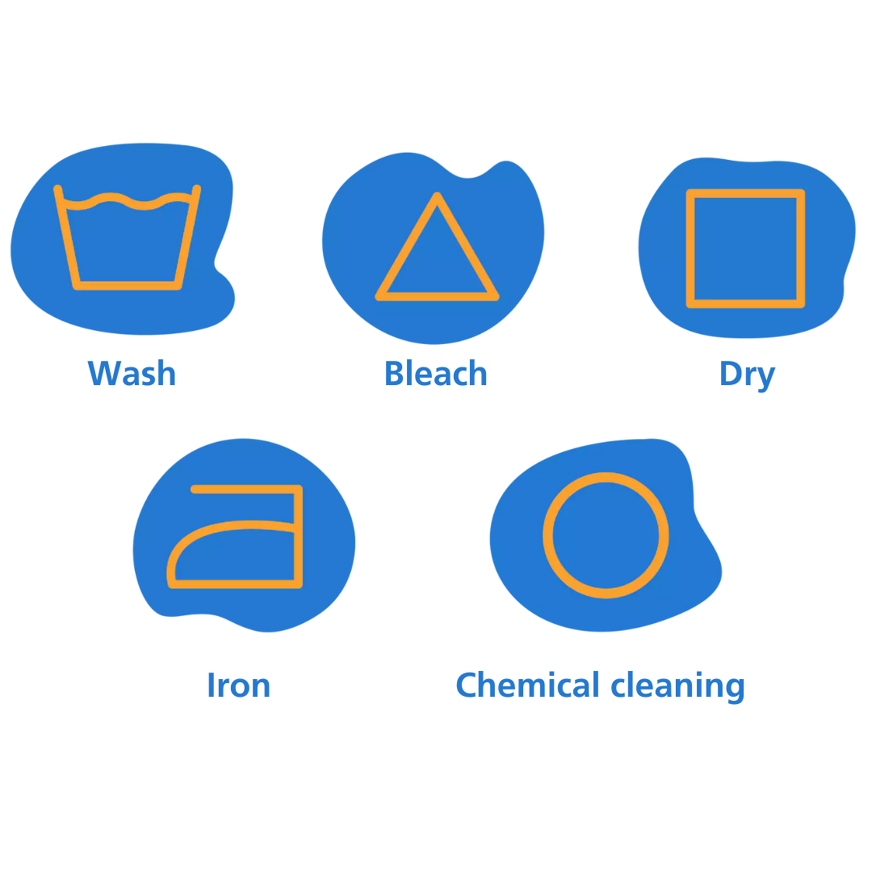
The extensions of the individual symbols provide more detailed explanations on how a piece of textile should be treated and allowed.
You can find a detailed explanation of each symbol below. ⬇️
Laundry symbol buckets: Washing and spinning
The first laundry symbols we want to examine more closely are the washing machine symbols.
They depict a bucket, or more precisely, a wash tub with a wavy surface to represent water.
Additionally, the tub may contain a number or a symbol that provides information about the washing temperature.

Common temperature zpecifications:
- 30°C
- 40°C
- 60°C
- 70°C
- 95°C
In some cases, the recommended temperature is not indicated by numbers but by symbols.
Here is the overview table with washing instructions:
| Washing machine symbols | Meaning |
| Bucket with 1 point | max. 30 degree washable |
| Bucket with 2 points | max. 60 degree washable |
| Bucket with 3 points | max. 95 degree washable |
For textiles such as bed linen, and mattress protectors, it's best to wash them as hot as possible to kill bacteria as effectively as possible.
For silk pillow covers you have to be careful with washing (max. 30 degree).

The tub also indicates the recommendation for spinning.
A simple tub without additional symbols means that the product is easy-care and can be spun at maximum strength. 🤗
If you see a line under the tub, it signifies gentle spinning, such as a wool wash cycle.
Two lines indicate that the textile should not be spun and requires a gentle treatment.
To carry out the cleaning properly, you should also be familiar with washing machine symbols and their exact meanings!
Washing symbols for hand washing and gentle washing
If you appreciate delicate materials like silk and linen, you know that not every fabric can be machine-washed.
If you find a tub with a line through it on the care label, it means the textile should not be machine-washed and should be taken to a professional cleaner. ❌

Another important washing machine symbol is the tub with a hand. This laundry symbol indicates hand washing.
This means that a garment should not be spun or washed in hot water; instead, it should be rinsed gently with a small amount of detergent and lukewarm water.
Washing symbols triangle: Bleaching
Secondly on a textile label, you'll find the washing machine symbol for bleaching.
This indicates whether you can safely bleach a textile at home or if bleach can be used for cleaning.
Bleaching products contain either hydrogen peroxide [1], hydrocarbons, or chlorine [2].
However, in many other countries, it's quite normal to add a splash of bleach to white bed linen, as bleach not only effectively removes stains but also kills bacteria.
There are 3 types of bleaching symbols:
| Washing instruction symbols | Meaning |
| empty triangle | bleaching allowed |
| crossed out triangle | do not bleach |
| triangle with two diagonal stripes | bleach without chlorine |
And here is how they look:
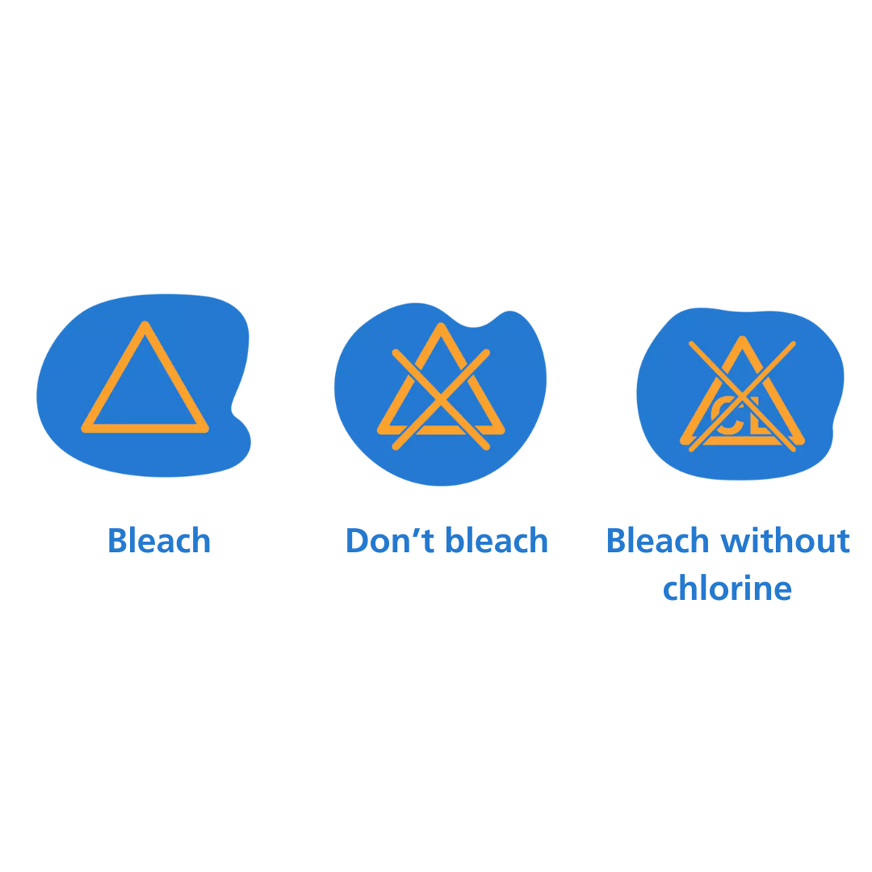
Washing symbols square: Drying
The next washing instruction symbol on a textile label is the dryer symbol. 🌬
It is a circle within a square with additional dots to provide precise information.
These symbols indicate whether a garment is suitable for tumble drying.
| Washing instruction symbols | Meaning |
| Circle in square with 1 dot | tumble dry gentle |
| circle in square with 2 dots | tumble dry normal |
| circle in square with 3 dots | tumble dry hot |
The more dots there are, the higher the temperature you can set the dryer to.
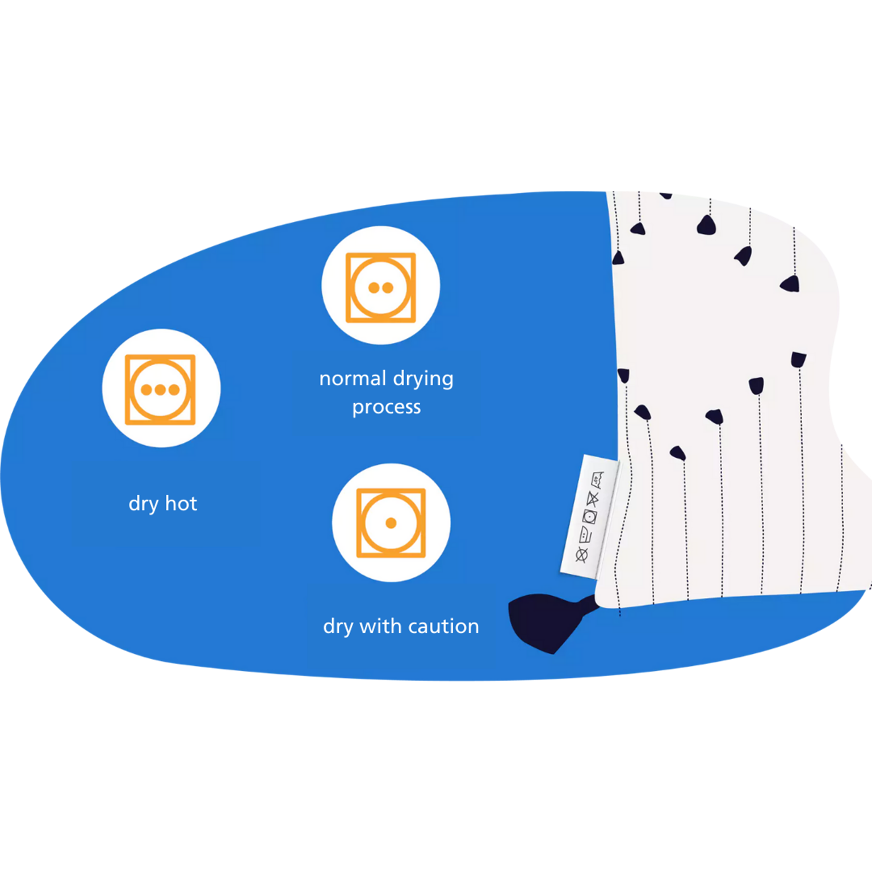
When it comes to using a dryer, caution is definitely warranted! 🛑
There are many materials that should not be dried at high temperatures or should not be put in the dryer at all. These include:
- Elastane
- Polyester
- Viscose
- Cashmere
- Silk
- Wool
Delicate fabrics should ideally not be placed in the tumble dryer, as they can shrink quickly and no longer fit properly.
These textiles are also marked with a special symbol — a triangle inside a square with a line through it.
For drying, this means you should hang or lay the garment on a clothesline and let it air dry naturally. ✅
Laundry symbols iron: Ironing
Next, we have the ironing symbol, which indicates whether and how hot a textile can be ironed.
There are 4 variations:
| Washing symbol | Meaning |
| Crossed out iron | do not iron |
| iron with 1 dot | iron up to 110 degree |
| iron with 2 dots | iron up to 150 degree |
| iron with 3 dots | iron up to 200 degree |
Here is how the symbols look:

These instructions may seem difficult to understand for many.
So, how hot is an iron, really?
In fact, there are specific temperature settings on the iron itself—so you don’t need to worry.
As a general reference, you can iron a regular garment made from a blend of wool, polyester, and elastane at up to 150°C.
Be cautious with prints and decorations on T-shirts!
They can peel off or stick if you apply an iron to them. 🤦♂️
Washing symbols circle: Dry cleaning
The last symbol you’ll find on a clothing label is a circle.
This indicates dry cleaning.
Typically, you don’t perform professional cleaning at home. However, this symbol is important when you have a garment cleaned professionally. 🌡

This way, the staff at the cleaning company knows how to treat the garment, for example, whether it should be cleaned with wet or dry cleaning methods.
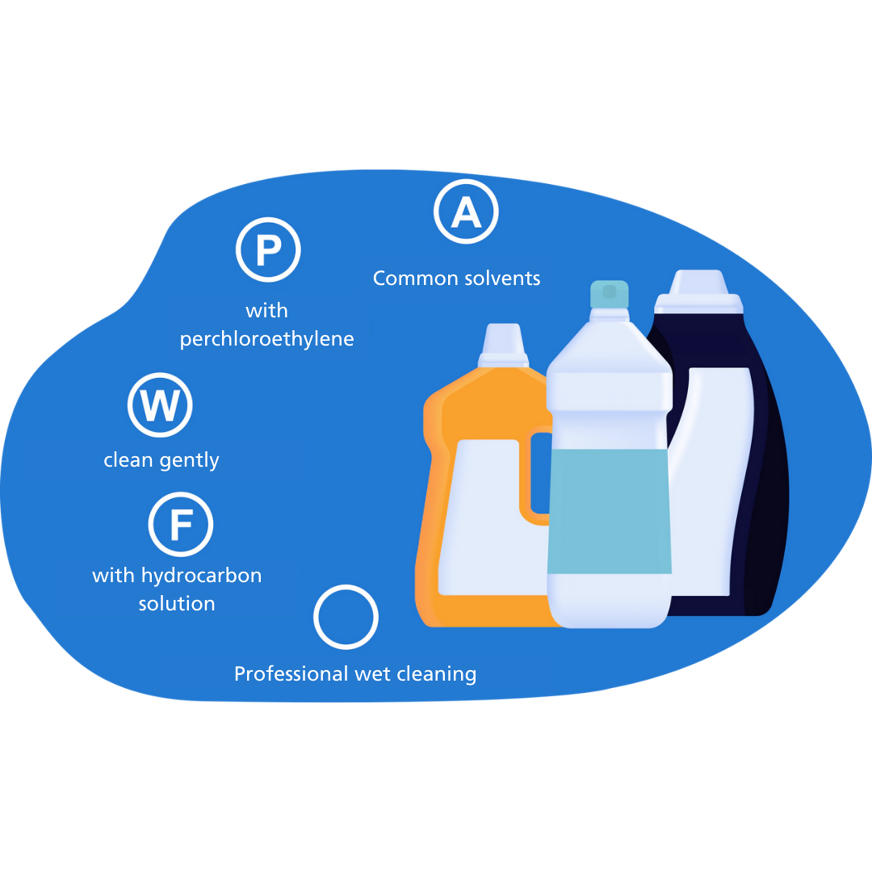
Further information on care symbols for textiles
Now that you know the meaning of the various washing symbols, here are some additional details for you. 👇
Where to find washing symbols and care labels
Washing symbols are found on the care label, which is sewn into all industrially produced textiles.
It is either white with black text or black with white text.
On garments, the care labels are always located on the left side.
With the trend towards sustainability, more and more manufacturers are printing the necessary information directly onto the garment to save resources.

The care label also contains additional information that is self-explanatory:
- Fabric composition
- Company name and address
- Additional care instructions for laundry
Are washing symbols the same worldwide?
In general, textile care symbols are internationally recognized, but they are not identical worldwide.
In the USA and South Korea, for instance, washing symbols may look slightly different compared to those within the EU.
Manufacturers who sell their products internationally often include labels with information in multiple languages and the appropriate symbols for various countries. 🗣
In the European Union, pictograms on textiles are mandatory and are regulated by the organization GINETEX [3].
Further information on proper washing
When it comes to washing clothes, there are generally two types of people:
- Those who meticulously follow the instructions and wash various materials separately.
- Those who wash all their clothes together, regardless of color or fabric.
But how important is it really to wash clothing correctly?

In fact, the way you wash your clothes affects their longevity.
Since we want to use our clothing, bed linen, and other textiles for as long as possible, we recommend adhering to the washing instructions and symbols.
Sorting laundry by material and color is indeed beneficial.
For delicate fabrics, a gentle detergent is suitable, while a color-protecting detergent is ideal for bright fabrics.
Additionally, you should wash these items only on a gentle cycle or by hand.

However, it's not necessary to have a whole range of different detergents at home and use a different one for each wash.
For most materials, a good universal detergent is sufficient. 👍
Also, you shouldn't use too much detergent. Adjust the amount according to the load size and level of soiling.


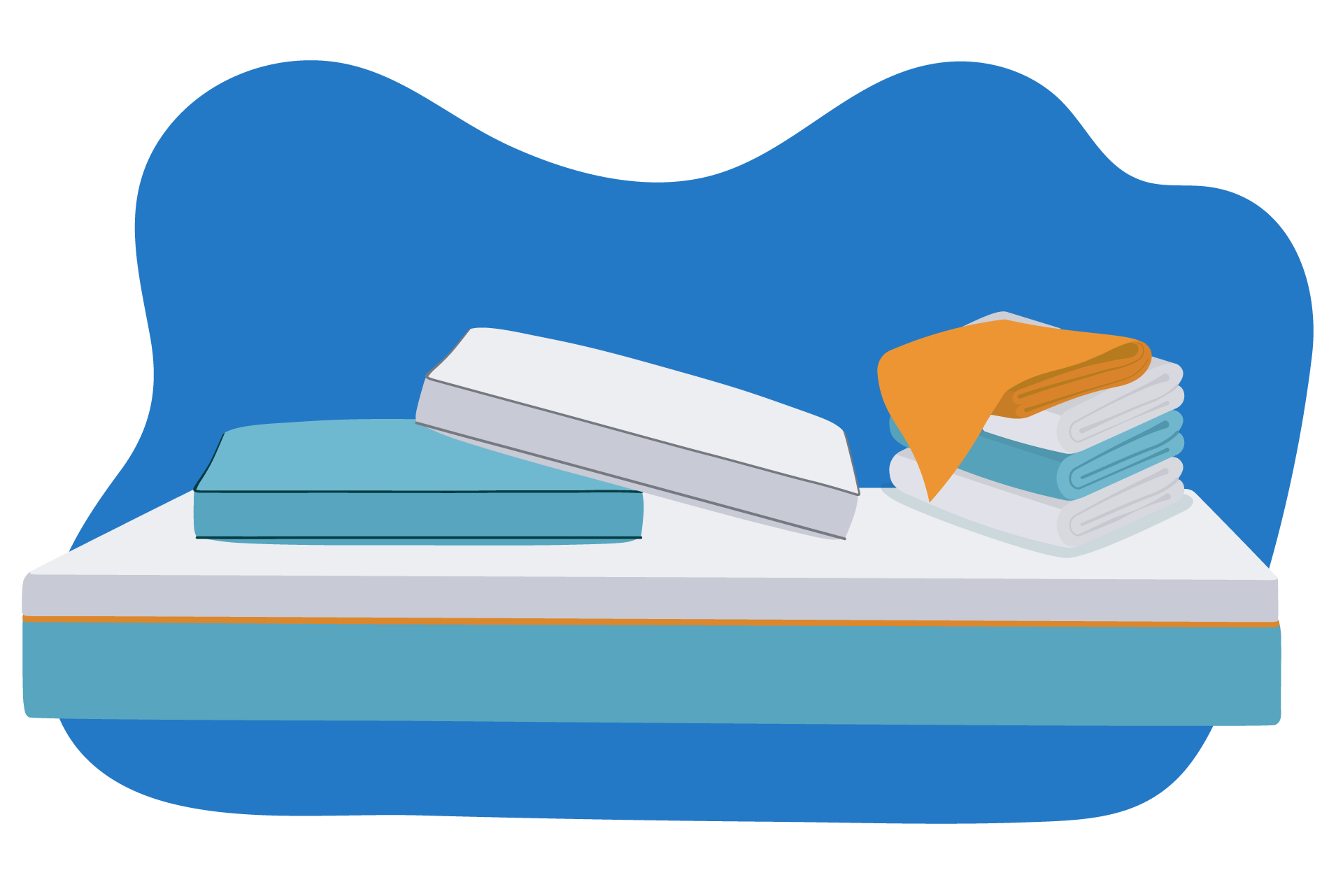









Alternatively, message us directly via the Contact Us page.